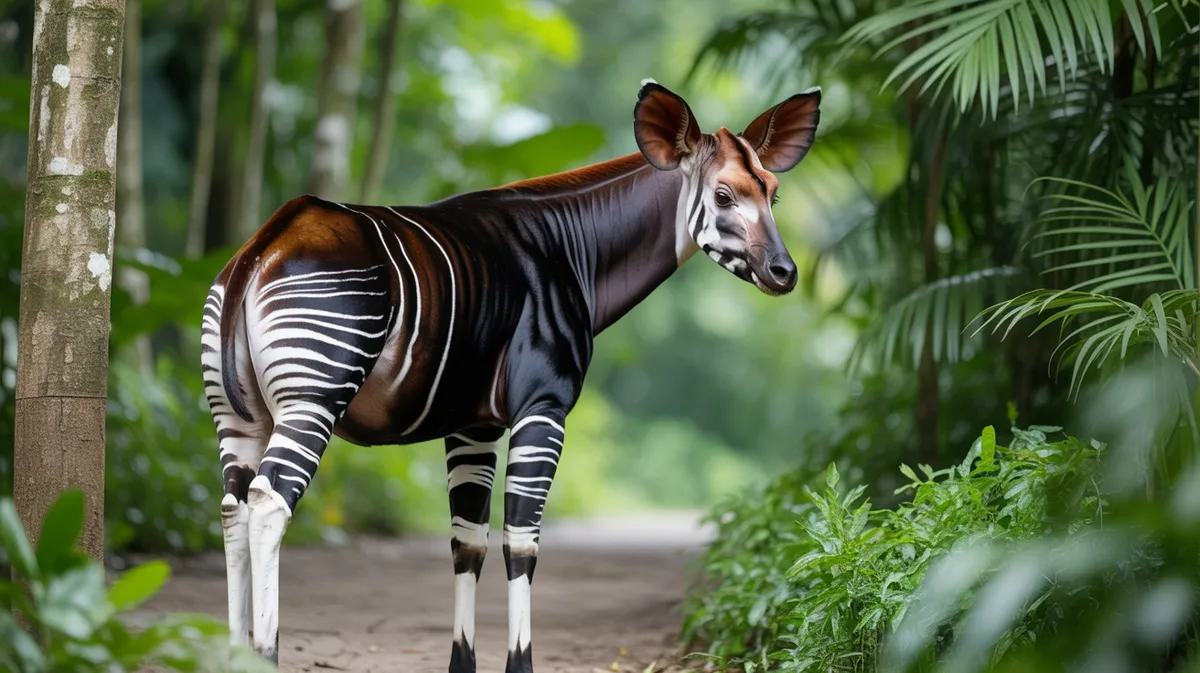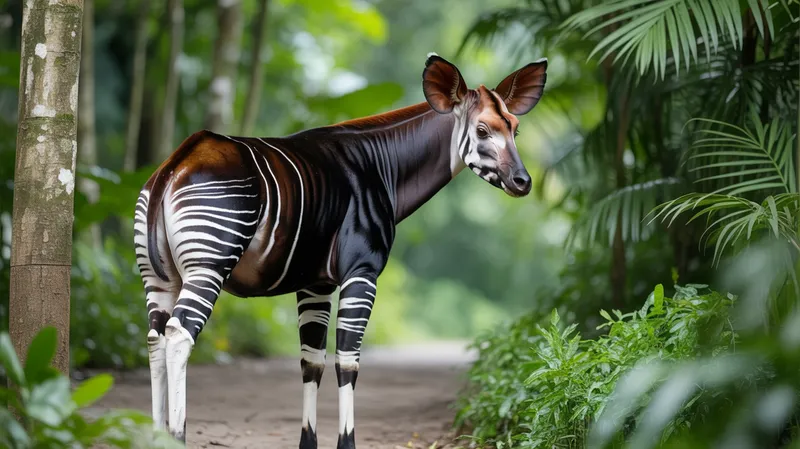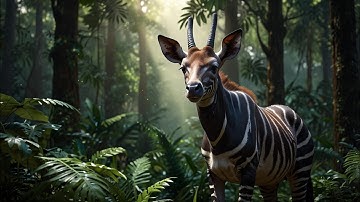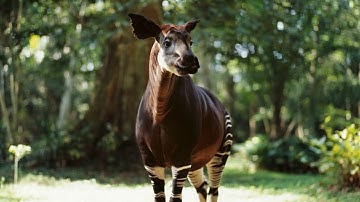
Okapi
Okapia johnstoni

Meet the Okapi
The okapi is a large, herbivorous mammal native to the dense rainforests of the Democratic Republic of the Congo in Central Africa. Often called the 'forest giraffe,' the okapi has a unique appearance, featuring a velvety dark brown body, striking white horizontal stripes on its legs, and a long, flexible tongue. Despite its zebra-like markings, the okapi is more closely related to the giraffe, sharing several anatomical features such as a long neck and ossicones (skin-covered horn-like structures) on males. Okapis are shy, solitary animals, relying on their keen hearing and camouflage to avoid predators in their dense, shaded habitat.
Classification
Mammal
Habitat
Dense tropical rainforest
Diet
Herbivore
Lifespan
20–30 years
Conservation
Endangered
Weight
200–350 kg
📖Fascinating Facts
Rainforest Dweller
Okapis are found exclusively in the dense, lowland rainforests of the Congo, making them one of Africa’s most elusive large mammals.
Incredible Tongue
Their long, blue-black tongue is prehensile and can clean their own eyes and ears as well as grasp leaves and buds.
Giraffe Relative
Despite their appearance, okapis are the closest living relatives of giraffes, sharing many skeletal and physiological traits.
📋Detailed Description
The okapi (Okapia johnstoni) is a medium-sized ungulate, standing about 1.5–2.0 meters (4.9–6.6 ft) tall at the shoulder and weighing between 200–350 kg (440–770 lbs). Its body is covered in a dense, velvety, chocolate-brown coat, which contrasts sharply with the striking white horizontal stripes and rings on its legs and hindquarters—a form of disruptive camouflage in the dappled light of the rainforest understory. The okapi’s head is elongated, with large, flexible ears that can independently rotate to detect faint sounds, aiding in predator avoidance. Males possess short, skin-covered ossicones, while females lack these structures. The okapi’s prehensile tongue, which can extend up to 45 cm (18 in), is adapted for selectively browsing leaves, buds, and fruits from understory vegetation. The animal is primarily diurnal and crepuscular, with peak activity in the early morning and late afternoon. Okapis are solitary and territorial, marking their ranges with scent glands located on their feet. Their digestive system is specialized for a high-fiber, low-nutrient diet, and they are known to consume clay and charcoal to supplement minerals. The species exhibits a slow reproductive rate, with females giving birth to a single calf after a lengthy gestation period. Okapis are highly elusive, relying on their cryptic coloration and stealthy movements to evade predators such as leopards.
💡 Did you know?
Despite their zebra-like stripes, okapis are the only living relative of the giraffe and are not closely related to zebras at all.
🔬Research & Sources
Wikipedia Summary
The okapi, also known as the forest giraffe, Congolese giraffe and zebra giraffe, is an artiodactyl mammal that is endemic to the northeast Democratic Republic of the Congo in central Africa. However, non-invasive genetic identification has suggested that a population has occurred south-west of the Congo River as well. It is the only species in the genus Okapia. Although the okapi has striped markings reminiscent of zebras, it is most closely related to the giraffe. The okapi and the giraffe are the only living members of the family Giraffidae.
Last Modified: 6/6/2025
🎭Behavior & Social Structure
Okapis are solitary, with individuals maintaining overlapping home ranges of 2.5–5 km², although direct encounters are rare outside of mating. They communicate through low-frequency vocalizations, scent marking, and occasional visual signals. Feeding is primarily selective browsing, with okapis using their long tongues to strip leaves, buds, grasses, ferns, fungi, and fruits from a wide variety of plant species—over 100 have been recorded in their diet. They are known to visit mineral-rich clay licks, which may aid in detoxifying plant secondary compounds. Okapis are crepuscular, spending much of the day foraging and resting in dense cover. They are highly sensitive to disturbance and will freeze or silently slip away if threatened. Grooming is important, with individuals using their tongues to clean their eyes and ears. Calves exhibit a 'hiding' strategy, remaining motionless and concealed for weeks after birth to avoid predation.
👶Reproduction & Life Cycle
Okapis are polygynous, with males seeking out females in estrus by following scent trails. Courtship involves mutual sniffing and circling, followed by brief copulation. The breeding season is not strictly defined but peaks during the rainy season when food is abundant. Gestation lasts approximately 440–450 days (about 14.5 months), after which a single calf is born, weighing 16–30 kg (35–66 lbs). Calves are precocial but remain hidden in vegetation for up to 60 days, visited by the mother only for nursing. Weaning occurs at 6–9 months, and sexual maturity is reached at 2–3 years for females and 3–4 years for males. Parental care is provided solely by the mother, who is highly attentive during the calf’s early life.
🛡️Adaptations & Survival
The okapi’s cryptic coloration provides effective camouflage in the rainforest’s patchy light, while the white leg stripes may help calves follow their mothers. Its long, prehensile tongue allows for precise foraging in dense vegetation and facilitates grooming. Large, independently mobile ears enhance auditory perception, crucial for detecting predators. The okapi’s digestive tract is adapted for processing fibrous, tannin-rich foliage, and its habit of geophagy (clay consumption) helps neutralize plant toxins. The species’ solitary and secretive nature reduces detection by predators and human hunters.
🎨Cultural Significance
The okapi holds a unique place in local folklore, often regarded as a symbol of secrecy and elusiveness. Indigenous Mbuti pygmies refer to the animal as the 'African unicorn' and have long recognized its presence, though it remained unknown to Western science until the early 20th century. The okapi is a national symbol of the Democratic Republic of the Congo, appearing on banknotes and as the emblem of the Institut Congolais pour la Conservation de la Nature (ICCN). There are no significant traditional uses of okapi parts, but its rarity and mysterious nature have inspired conservation awareness and ecotourism initiatives.
🔬Recent Research & Discoveries
Recent advances in non-invasive genetic sampling have revealed previously unknown populations of okapi south-west of the Congo River, expanding the known range and underscoring the importance of genetic monitoring. Camera trap studies have provided new insights into okapi habitat use, activity patterns, and population densities. Ongoing research focuses on the impact of habitat fragmentation, disease ecology (notably susceptibility to rinderpest and other livestock diseases), and the effectiveness of protected areas such as the Okapi Wildlife Reserve. Conservation genetics is a growing field, with efforts to assess genetic diversity and inform captive breeding programs. The okapi genome was sequenced in 2016, providing valuable data for evolutionary studies within Giraffidae.
🎥Wildlife Videos

Exploring the Okapi Wildlife Reserve: A Hidden Gem in the Congo
Discover the enchanting Okapi Wildlife Reserve in the heart of the Congo Basin! This video explores the reserve's incredible ...
World Wonders

Okapi - 5 Minute Documentary
Embark on a mesmerizing five-minute documentary journey into the enchanting realm of the Okapi, a truly captivating creature ...
Five Minute Documentaries

The stunning biodiversity of the Okapi Wildlife Reserve: Camera Trap Compilation
Watch this short video to give you a boost today! The Okapi Conservation Project has compiled videos taken by camera traps in ...
Synchronicity Earth

Okapi Animal Documentary 🦓 | Rare Jungle Creature, Sounds & Facts You’ve Never Seen!
Have you ever heard of the **Okapi** — also known as the **forest giraffe**? It's one of the **rarest and most mysterious animals ...
Wild Wonders

The Mysterious Okapi: The Forest’s Hidden Jewel
Discover the enigmatic world of the Okapi in "The Mysterious Okapi: The Forest's Hidden Jewel." Nestled deep in the Congo ...
Animal Profiles

Okapi | Wildlife Documentary | Informative #biography #wildbirds#seaanimals#desertanimals#wildlife
Okapi | Wildlife Documentary | Informative #biography #wildbirds#seaanimals#desertanimals#wildlife ...
Animals World.official
🌍Habitat Information
The Okapi typically inhabits Dense tropical rainforest environments. Okapis have adapted to their environments with specialized features and behaviors.
Primary Habitat:
Dense tropical rainforest
More detailed habitat information will be available soon.
🛡️Conservation Status
The Okapi is currently classified as Endangered. Conservation efforts are crucial for preserving this species for future generations.
Common Threats:
- 🏠Habitat loss and fragmentation
- 🌡️Climate change impacts
- 🎯Hunting and poaching
- 🏭Human-wildlife conflict
⚠️Threats & Conservation Challenges
Okapis face significant threats from habitat loss due to logging, mining, and agricultural expansion in the Democratic Republic of the Congo. Poaching for bushmeat and skin, as well as snares set for other animals, also contribute to mortality. Political instability and armed conflict in the region hinder conservation efforts and increase human encroachment. The okapi is classified as Endangered by the IUCN, with population estimates suggesting fewer than 10,000 individuals remain in the wild, and numbers are declining. Fragmentation of habitat and reduced genetic diversity are additional concerns, making the species highly vulnerable to environmental changes and disease.
🔬Scientific Classification
Scientific Name
Okapia johnstoni
Classification Hierarchy
🔍 About Taxonomic Classification
Taxonomic classification is a hierarchical system used by scientists to classify and organize living organisms based on shared characteristics and evolutionary relationships.
The system moves from broad categories (Kingdom) to increasingly specific ones, with each animal's scientific name typically consisting of its Genus and species.
📝Community Notes
Share your observations and insights about the Okapi with our community of wildlife enthusiasts.
Join Our Community
Sign in to share your observations and connect with fellow wildlife enthusiasts.
Sign In to ContributeNo community notes yet
Be the first to share your observations about the Okapi!
Explore Okapi
Select a tab above to learn more about this amazing animal.
📸Photo Gallery
No photos available for this animal yet.
🌟Discover More Wildlife
Continue your journey of discovery with more fascinating animals from our database
